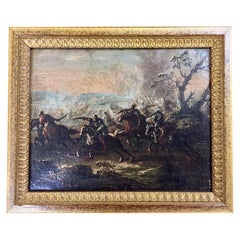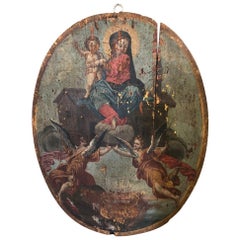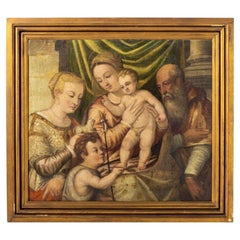Francesco Graziani Furniture
Italian
Francesco Graziani was best known as "Ciccio Napoletano" and “Napoletan Ciccio” and was always associated with military art.
to
1
1
1
1
1
1
1
1
1
1
1
2
7,546
3,967
2,548
2,244
Creator: Francesco Graziani
Francesco Graziani, Called Ciccio Napoletano, 17th Century
By Francesco Graziani
Located in CH
Francesco Graziani, Called Ciccio Napoletano, 17th Century
He was active in Naples and Rome around the second half of the 17th Century.
Category
Late 17th Century Italian Baroque Antique Francesco Graziani Furniture
Materials
Canvas
Related Items
17th Century Venetian Oil Painting
Located in Atlanta, GA
An outstanding and grand 17th century Baroque oil painting on an oval wooden panel of the Madonna and Child. Beautifully executed and stunning patina.
Category
17th Century Italian Antique Francesco Graziani Furniture
Materials
Wood
Flemish School 17th Century
Located in Madrid, ES
Flemish school 17th century
"Our Lady with the Child Jesus, St. John, St. Elizabeth and Zacarias".
Oil on canvas Relined.
Dimensions: 74 x 84 cm
good conditions.
Category
17th Century Dutch Baroque Antique Francesco Graziani Furniture
Materials
Paint
Oil on Copper, 17th Century
Located in Madrid, ES
Oil On Copper, 17th Century
ELEGANT OIL ON COPPER REPRESENTING THE VIRGIN MARY SPANISH SCHOOL OF THE 17TH CENTURY VERY WELL PRESERVED CONDITION GILT WOOD FR...
Category
Late 17th Century Antique Francesco Graziani Furniture
Materials
Copper
Italian School "Apostle" 17th Century
Located in Madrid, ES
Italian School
"Apostle" 17th Century
Oil on oak wood
Carved and gilded wooden frame.
Small defects.
Dim.: 44 x 58 cm
good conditions
Category
17th Century Italian Baroque Antique Francesco Graziani Furniture
Materials
Paint
17th Century Onorio Marinari Italian Religious Painting
By Onorio Marinari
Located in Roma, IT
A very important painting by the great artist of the Florentine school, Onorio Marinari.
Dr. Silvia Benassai has confirmed Marinari’s authorship of the Saint Margaret of Antioch; available on demand, a historical-artistic fact sheet prepared by Dr. Silvia Benassai
Onorio Marinari (1627 – 5 January 1715) was a very important Italian painter and printmaker of the Baroque period, active mainly in Florence.
His father, Sigismondo di Pietro Marinari, was also a painter, and he trained with his cousin, Carlo Dolci, later being also influenced by Simone Pignoni and Francesco Furini.
His fresco in the Palazzo Capponi, Florence, is dated 1707. He worked mainly in Florence for Florentine and Tuscan clients, but he did not devote himself only to painting.
In fact, in 1674, he published an essay on astronomy entitled Fabbrica ed uso dell' Annulo Astronomico. Bartolomeo Bimbi was one of his pupils.
St. Margaret of Antioch
July 20, Martyr
Margaret, known as Margaret of Antioch in the West, and as Saint Marina...
Category
Mid-17th Century Italian Baroque Antique Francesco Graziani Furniture
Materials
Canvas, Wood
Italian School "Apostle" 17th Century
Located in Madrid, ES
Italian School
"Apostle" 17th Century
Oil on oak wood
Carved and gilded wooden frame.
Small defects.
Dim.: 44 x 58 cm
good conditions
Category
17th Century Italian Baroque Antique Francesco Graziani Furniture
Materials
Paint
Unknown Flemish Artist, 17th-18th Century
Located in Belmont, MA
Unknown Flemish artist, 17th-18th century, “Judith and Holofernes”, oil on canvas 20.47 x 19.68 inches (52 x 50 cm) (lined), not signed. The painting c...
Category
Late 17th Century Belgian Baroque Antique Francesco Graziani Furniture
Materials
Canvas
17th Century Painting
Located in Miami, FL
17th century painting
J.Castano
17th century
Spain
Category
17th Century Baroque Antique Francesco Graziani Furniture
Materials
Canvas
Baroque Christ Salvator Mundi Painting, 17th Century
Located in Lisbon, PT
A 17th Century baroque painting of a sideview of Jesus Christ Salvator Mundi or Saviour of the World in sfumato
Saint Savior of the World, a title given to Christ on the Catholic f...
Category
17th Century Italian Baroque Antique Francesco Graziani Furniture
Materials
Copper
17th-18th Century Venetian Painting
Located in Pembroke, MA
Venetian School painting of four angels, allegorically depicting the variable winds of change and time. Unsigned, believed to be by a follower of Pietro Li...
Category
17th Century Italian Baroque Antique Francesco Graziani Furniture
Materials
Giltwood, Canvas
17th Century, Italian Painting by Pier Francesco Cittadini, Jacob and his Family
Located in IT
Pier Francesco Cittadini (Milan, 1616-Bologna, 1681)
"Jacob and his family go to Egypt"
Oil on canvas, cm 109 x 190 (canvas only)
The valuable painting, made in oil on canvas, depicts Jacob and his family go to Egypt and we believe it can be, given the high quality painting, autograph work of Italian Pier Francesco Cittadini (Italy Milan, 1616 - Bologna, 1681) made after 1647. The work, in excellent condition is accompanied by a coeval frame in wood finely carved and golden.
The scene depicted, which was confused with the Flight to Egypt in the past years, is instead identified with the biblical episode of Jacob’s journey. In the foreground, reading the painting from left to right, we see a caravan composed of animals, including donkeys, dromedaries, goats, dogs and horses and people, women, men and slaves, who carry on their journey along the banks of a river, following a path that to the right, would seem to lead to the through of a bridge. In addition to the watercourse is described an environment characterized by large rocks and impervious come far to cover the entire verticality of the canvas. On the left, in the distance, we see the tail of the caravan that runs along the steep path. Large trees enliven and harmonize the environment, as well as white and grey clouds characterize the predominantly clear sky and illuminated on the right by sunlight.
The story is told in the Bible, Book of Genesis, 30, 25, passage in which is described the flight of Jacob from Haran after the contrasts with Laban, father of his wife Rachel. Jacob is the third great patriarch of the Bible. From his descendants originate the twelve generations of the people of Israel. He is the son of Isaac and Rebekah, who led him to flee from the wrath of Esau to Haran to seek refuge from his brother, Laban. At his uncle’s house Jacob met his daughter Rachel. As soon as he saw his cousin, Jacob was taken. Jacob will stay seven years in the service of Laban to marry his beloved Rachel. But Laban, with a deception, will give him in marriage first Lia, the least beautiful eldest daughter, and only after another seven years the splendid Rachel. From his first wife he will have several children, while Rachel will give birth to the beloved son, Joseph, who will become viceroy of Egypt.
After years of service, Jacob asked to be paid with every dark-coloured garment among the sheep and every spotted and dotted garment among the goats. Laban accepted and sent away from his sons all the leaders of that kind. So Jacob took fresh branches of poplar, almond and plane tree, and flayed them, and put them in the troughs. The optical suggestion induced the goats and the sheep to conceive and give birth to dark, striped and dotted garments. He also ensured that all the strongest and healthiest leaders of the flock of Laban would drink near the barked branches, thus assuring a genetic superiority to his part of the flock. His flocks grew numerous and strong and he became richer than his relative, arousing envy. It was clear that Laban would not respect him much longer. At the suggestion of the Lord, Jacob decided to return to Canaan. Trying to avoid any possible dispute, he left with his family while Laban was absent for shearing sheep. But when, three days later, his uncle returned home, he became angry, feeling offended because Jacob had gone secretly and had not allowed him to greet his daughters and grandchildren. In addition, his teraphim, statuettes, or idols, which depicted the family deities, had disappeared. After 7 days of pursuit, Laban and his men reached Jacob’s group on Mount Gilead, in the mountainous region west of the Euphrates River, where his uncle and grandson had a stormy conversation. The younger man was outraged at being accused of stealing idols and told Labano to rummage through his family’s tents at will. Neither of them could know or even imagine that it was Rachel who took the idols and hid them in the saddle of the camel. During the search, she sat down firmly on the saddle, apologizing for not being able to get up, «because I usually have what happens to women» (Gen 31:35). So the loot wasn’t discovered.
The author of this work was inspired by the composition of an engraving by Stefano Della Bella (1610-1664) of circa 1647. The engraving by Stefano della Bella bears the title "Iacob sur ses vieux jours quitte sans fascherie pour voir son filz Ioseph, sa terre et sa patrie" and is signed on the bottom left "Stef. of the Beautiful In. et fe." while on the right it is declared "Cum privil. Regis", that is with license of the king.
Stefano Della Bella (Italy - Florence, May 18, 1610-Florence, July 12, 1664) was born in a family of painters, sculptors and goldsmiths and was left early orphan of his father sculptor, he dedicated himself first to the art of goldsmith at the school of Giovanni Benedetto Castiglione and Gasparo Mola, then turning his attention to drawing and engraving. He soon began drawing figures and copying the etchings of Jacques Callot, which inspired his early works. Under the protection of the Medici, in particular of Don Lorenzo, cadet son of Grand Duke Ferdinand I, Della Bella has the opportunity to make study trips to Rome, where he stayed from 1633-1636; In Rome he met French engravers and publishers of prints such as Israël Henriet and François Langlois, who influenced his decision to move to Paris in 1639, four years after the death of Callot. In Paris he soon reached, thanks to the engravings commissioned by Cardinal Richelieu, the success also worldly; he frequented courtiers, theatre artists and writers, while refusing too oppressive honors. In 1646-1647 he continued his travels in the Netherlands to Amsterdam, Antwerp and Dordrecht. He returned to Florence in 1650 and resumed working under the protection of the Medici court, working for his patrons. In 1656 he became a member of the Academy of Apatists.
The painting object of this study is reasonably attributable to Pier Francesco Cittadini, or Pierfrancesco Cittadini, called the Milanese or the Franceschino (Italy - Milan, 1616-Bologna, 1681) as some exemplary stylistic comparisons proposed to follow can prove.
Pier Francesco Cittadini was an Italian baroque painter, mainly active in Bologna.
His artistic training first took place with the painter Daniele Crespi...
Category
Mid-17th Century European Baroque Antique Francesco Graziani Furniture
Materials
Canvas, Giltwood
H 57.09 in W 84.26 in D 3.94 in
Flemish School "Landscape" 17th Century
By Flemish
Located in Madrid, ES
OIL ON CANVAS OF 17th Century
LANDSCAPE OF WINTER OF THE NETHERLANDS.
Good CONDITION.
MEASURES WITH FRAME: 114X90 CM WITHOUT FRAME: 96X74 CM
Category
17th Century Dutch Baroque Antique Francesco Graziani Furniture
Materials
Paint
Francesco Graziani furniture for sale on 1stDibs.
Francesco Graziani furniture are available for sale on 1stDibs. These distinctive items are frequently made of fabric and are designed with extraordinary care. There are many options to choose from in our collection of Francesco Graziani furniture, although brown editions of this piece are particularly popular. Many of the original furniture by Francesco Graziani were created in the Baroque style in italy during the 18th century and earlier. If you’re looking for additional options, many customers also consider furniture by and Matthäus Merian the Elder. Prices for Francesco Graziani furniture can differ depending upon size, time period and other attributes — on 1stDibs, these items begin at $3,800 and can go as high as $3,800, while a piece like these, on average, fetch $3,800.


